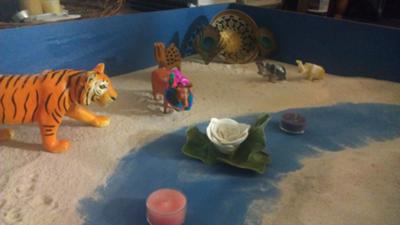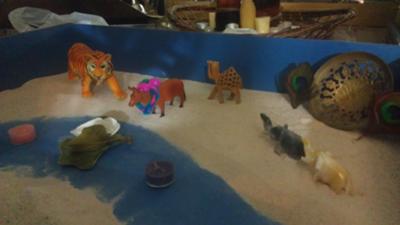Sand Tray Therapy Miniatures: Hindu Symbols of India
by Marie
(Atlanta)
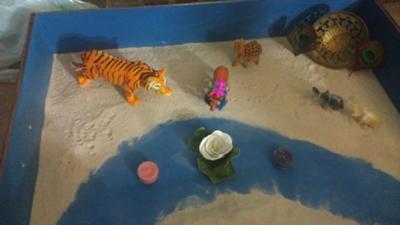
Sand Tray Therapy Miniatures: Hindu Symbols of India
Sand Tray Therapy Miniatures: Hindu Symbols of India
The Bengal Tiger
The Bengal tiger is native to eastern and southern Asia. Throughout the world the tiger symbolizes prosperity, strength, and agility. It is also seen as the essence of the feminine force. In India it has come to earn the name of “Lord of Jungles” or the “Royal Bengal Tiger” due to its characteristics. The tiger is a relatively solitary animal and is rarely seen by humans. The tiger is the national animal of India.
The Hindu goddess Durga, who is known as the “invincible one,” rides the tiger. Durga came into being when the gods could not defeat the demon Mahisha. Mahisha had taken on the form of a giant buffalo and was causing pain and devastation. The gods begged Shiva, the god of destruction, for assistance to destroy Mahisha but instead he told them to combine their spiritual powers. From this combination came Durga, a beautiful goddess with many arms. The goddess was as beautiful as she was deadly, armed with a weapon from each of the gods who formed her. Well armed, Durga rode on the back of a tiger to the top of the mountain and destroyed Mahisha and his fellow demons. Durga riding on the back of a tiger symbolizes her power and strength over evil forces and nature’s destruction. Durga protects humans from evil and misery by destroying evil forces such as selfishness, jealousy, prejudice, hatred, anger, and ego. As protector, Durga chose the tiger to show that she has dominion over all of nature.
The tiger is revered and yet also feared. The tiger is considered the guardian of the jungle. As Lord of the Jungle, the tiger protects, guards, and kills those breaking the laws of the jungle. People in India understand that not only is the tiger the protector of the jungle but that it is a fierce and dangerous animal that kills and yet it is beautiful. Many sayings in India refer to the tiger’s strength and suggests that if a person wants to prove then they must be stronger than a tiger.
As a miniature the tiger can symbolize strength and beauty. It can also symbolize the dichotomy of character. The tiger may be used to symbolize fierce protectiveness and act as a guardian.
Elephant
The elephant has been revered in South Asia from the earliest times. As a huge and gray animal, the elephant has resembled the dark clouds of a rain storm that waters the land. The association of elephants with rain and water can be found throughout various myths in Hinduism. The myth of the anointing of the goddess Laksmi, the wife of Vishnu and giver of well-being, involves elephants. As the myth gooes, Laksmi rose out of the ocean seated on a lotus. Ganga, the goddess of the Ganges River, and the other sacred rivers stood before Lakshmi and adored her. The elephants gathered pure waters in golden vessels and poured them over Lakshmi. Other myths directly link the elephants to gathering water in their trunks and spraying the earth with the water. Therefore an elephant with a raised trunk is a good omen or sign which indicates rain or blessing coming down.
Hinduism also reveres the elephant due to the story of Ganesh, the god of success and remover of obstacles. Ganesh was a child when he tried to protect his mother Parvati, the Divine Mother, from what he thought was an intruder. Ganesh’s father, Lord Shiva, had yet to meet Ganesh and was attempting to walk into Parvati’s room. However Lord Shiva was being blocked by a young boy and beheaded the boy for blocking his path. Parvati came in distraught and told Lord Shiva that it was their child that he had beheaded. Lord Shiva immediately looked for the first animal and found a elephant walking by so he beheaded the elephant and placed the elephant head on his son’s body. Ganesh is now almost always pictured with an elephant head showing large listening ears and a big thinking head.
In the sand tray an elephant’s meaning will depend greatly on the client. However, it should be noted that the elephant is one of the largest land mammals and is known by most to be a highly intelligent animal.
Cow
Hinduism reveres cows as a source for food and a symbol of life. Cows are never killed and are not to be eaten either. Cows provide milk, labor, and religious inspiration. The cow therefore is a protected animal in Hinduism. Most rural Indian families have a dairy cow who is well taken care of and is often treated as a member of the family. In some parts of India it is considered good luck to give a cow a snack, a bit of bread, or fruit before breakfast.
The cow yields five different products which are used in worship and in penitent rites. These products are milk, curds, ghee butter, urine and dung. Milk nourishes the family and children in particular as they grow. Milk is central in some religious rituals. Cow dung is used throughout many parts of India as a major source of energy for households. Cow dung can also be among the materials used for a tilak, a ritual mark on the forehead. People throughout India regard cow dung as a natural product given by the cow.
The origin about the reverence for cows is somewhat ambiguous but some trace the cow's hallowed status back to Lord Krishna. Lord Krishna is an incarnation of Vishnu, the preserver god, making him one of Hindu’s most important figures. Lord Krishna is said to have appeared 5,000 years ago as a cowherd. He is often described as “bala-gopala” or "the child who protects the cows." Another of Krishna's holy names, “Govinda” means "one who brings satisfaction to the cows." Other sacred texts identify the cow as the "mother" of all civilization with its milk nurturing all people.
Cows in the sandtray can be interpreted many ways depending upon the client’s culture. Clients may view the cow as a provider of milk and nutrition but most will not revere the cows as a client who is Hindu. A Hindu client placing a cow in the tray may be showing signs of connecting the world to what is sacred.
Disclaimer: This website and its content is intended for trained licensed mental health professionals and school certified mental health professionals to use for their clients / students at their own discretion.
*If you ignore the disclaimer above are using these techniques on yourself and you feel any discomfort or upset it is highly suggested that you seek out a licensed mental health professional immediately.
"Beyond Art Therapy" is the concept from Dr. Stangline that combines all creative fields in therapy. It is not the traditional "art therapy" but goes beyond to include sand tray therapy, play therapy, mindfulness, meditation, color therapy, cognitive behavioral therapy, and a vast majority of other therapies.
For any other type of mental health emergency call your local 911 / Police Number immediately.
Dr. Stangline does not offer advice / suggestions to anyone who is not a professional mental health provider, or a student who is studying this field and has questions about mental health programs of study.
See our Exciting Selection of eBooks:
Award Winning:
Creative Counseling 101 eBook
Our Best Seller!
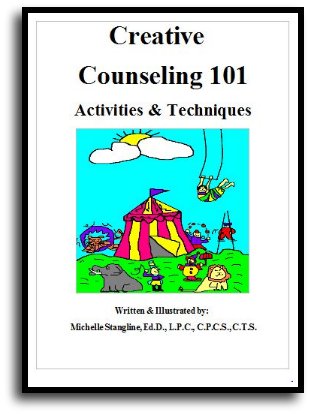
Step By Step Therapy:
Learn how to be a more Creative Therapist with the Book that started it all!
- Graduate School Counseling book used by hundreds of graduate counseling students!
- Includes full color reproducible worksheets with most activities.
- Winner of the Counselor Writer of the Year Award, 2011, Georgia Regional Award
Download Your Copy Today Only $39.95:
See Creative Counseling 101 eBook Information Here:
Get the Set
of all four
eBooks for only $98.95:
An incredible collection of how to do therapy eBooks!
A $159.80 Value,
You Save Over $60!
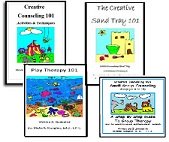
Get your complete set of the Creative Counseling 101.com eBooks by Dr. Michelle Stangline for only $98.95, that's less than $25.00 per eBook (Regular Price is $39.95 for each eBook.).
Your complete set includes:
- Creative Counseling 101
- Creative Group Counseling 101
- Creative Play Therapy 101
- Creative Sand Tray 101
For more information click the link below:
See Complete Set of eBooks For Sale Here:
New!!! "Beyond Art Therapy" 101 eBook
Over 300 pages of Beyond Art Therapy activities and techniques. Learn what I teach graduate counseling students!
See the link below for more information.
Only $39.95
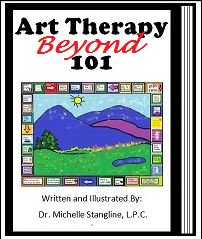
See More Invividual eBooks For Sale:
Sand Tray Therapy 101 eBook:
Learn how to do Sand Tray Therapy or enhance your skills.
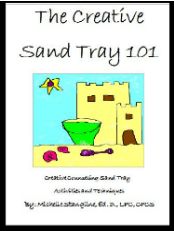
Play Therapy 101 eBook
Learn how to do play therapy or enhance your skills.
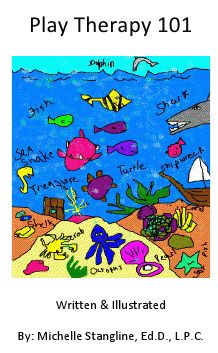
Small Group Counseling eBook For Sale:
Learn how to do creative group therapy and enhance your skills.

School Counselor Guidance Lesson & Social Stories eBook for sale:
Get a year's worth of school counselor guidance lessons with "Creative Warm & Fuzzy Classroom Guidance Lessons eBook". Introduce your students to the "Warm & Fuzzy Way". Click the link below for more information:
Warm & Fuzzy School Counselor Guidance Lessons eBook

